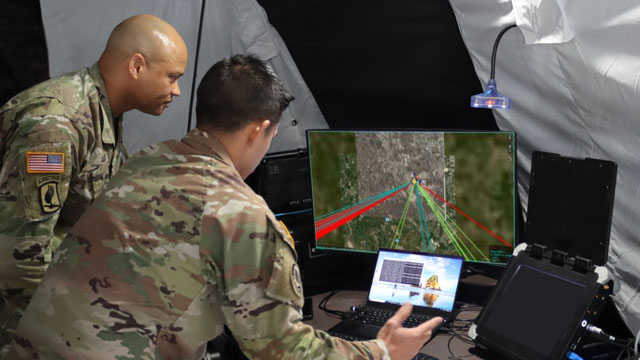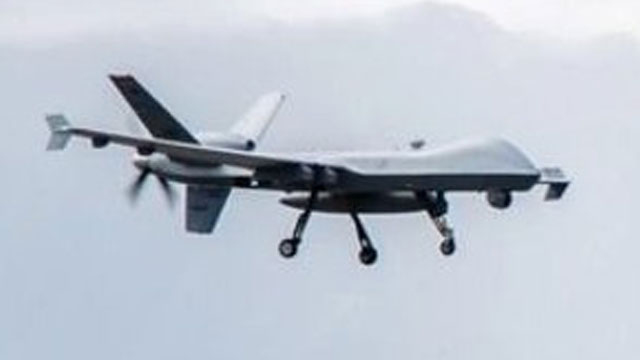By Allison Weissert |

The direct requirement concept micro-high-altitude balloons (mHAB) are small balloons able to transmit data at high altitude. (Photo Credit: Staff Sgt. Brandon Rickert)

EWPMT-X is the Commander’s tool to visualize, control, manage, and dominate the EMS. (Photo Credit: Army)

Common Sensor Payload provides reconnaissance, surveillance, target acquisition and intelligence gathering capabilities to the MQ-1C Gray Eagle (Photo Credit: Army)
Preparing for future battle, assessing readiness for unknown situations, and driving capability investments that protect the Soldier and the Nation are reasons why experimentation is a key step in enabling the Army of the future.
Project Convergence Capstone 5 (PC-C5) is a two phased experimentation event, Scenarios A and B, that Army Futures Command will lean into for learning and planning. The Army hosted the joint military experimentation event throughout March and April, at the National Training Center in Fort Irwin, California, Yakima Training Center in Washington, and various locations in the Indo-Pacific region, including Hawaii, Guam, the Philippines, Australia and French Tahiti. This experiment provided concept-driven activities, allowing decision makers to evaluate, identify and refine recommendations and requirements that enable future Army readiness. The event had multiple participants joining the Army including Navy, Air Force, Marine Corps, and Space Force, as well as foreign military partners from Australia, Canada, United Kingdom, New Zealand, and France.
Program Executive Office – Intelligence Electronic Warfare and Sensors (PEO IEW&S) recently participated in Scenario A with multiple products spanning intelligence, electromagnetic warfare and surveillance.
The event served as an opportunity to showcase the Army Intelligence Data Platform (AIDP), which updates the core technology fielded at the Army’s Fixed Sites and Military intelligence brigades with a modernized enterprise data warehousing and analytic solution. AIDP organizes data for better and faster information processing and decision making. U.S. Army Forces Command, Divisions, Corps, U.S. Army Intelligence and Security Command Military Intelligence Brigade, and U. S. Army Special Operations Command used AIDP to test interoperability with Next Generation Command and Control (NGC2), a portfolio of capabilities that will support better and faster decision making, at the tactical and cloud-based levels and maintain a shared common intelligence picture with replicated denied, disrupted, intermittent and limited bandwidth (DDIL) environments.
From an aerial perspective the PEO had a mix of new and enduring capabilities on hand to provide commanders with key views of the battlespace.
The Common Sensor Payload, a proven technology with some new updates, provided reconnaissance, surveillance, target acquisition (RSTA), and intelligence gathering capabilities to the MQ-1C Gray Eagle uncrewed aircraft system during PC C5. CSP’s participation in the event was supported by the Fires Center of Excellence and Long-Range Precision Fires Cross-Functional Team, with a goal of codifying tactics, techniques and procedures as well as demonstrate the ability to submit Digital Calls for Fire (DCFF) for timely processing and responsive engagement. CSP is certified interoperable across Army Battle Command systems and an upgraded version 3 will have a precision target location capability.
Additionally, PEO IEW&S supported the direct requirement concept micro-high-altitude balloons (μHAB).These are small balloons able to transmit data at high altitude. The goal of the experiment was to distinguish the differences between platforms from multiple vendors. The Army G2’s Intelligence, Surveillance, Reconnaissance (ISR) Task Force sponsored the experiment conducted with the First and Third Multi-Domain Task Forces (MDTF). Andrew Evans, Director of the ISR Task Force, championed the experiment saying, “The successful micro-HAB demonstration at Yakima Training Center marks a significant step forward in our pursuit of persistent, layered ISR capabilities. By evaluating multiple vendors and sensor technologies in challenging conditions, we’re not just validating technology readiness, we’re shaping the future of battlefield surveillance for our forces. Getting technology into our Soldier’s hands is how we win. Soldiers are the accelerant to refining requirements, developing concepts of employment, and enhancing the Army’s lethality.”
In addition to sensor and intelligence capabilities, several electromagnetic warfare (EW) systems participated in the exercise by providing multiple products and concepts, specifically to the 11th Cyber Battalion.
The Electronic Warfare Planning and Management Tool (EWPMT-X), a modernized prototype of the original EWPMT was amongst several systems identified as key technologies for PC-C5. At its end state, EWPMT-X will provide planning, modeling, and managing capabilities for multiple EW assets to execute operations, enhance targeting, and enable maneuver by synchronizing EW and spectrum management operations across intelligence, operations, and cyberspace in support of Multi-Domain Operations (MDO). During PC-C5 sensor data itself was visualized via EWPMT-X with the tool correlating data and passing it to other mission command systems that enabled Next Generation Command and Control.
Also integral to signals intelligence advancement is the Transformation in Contact (TiC) Mobile Node-Terrestrial (TMNT) system, an early prototype of Terrestrial Layer System – Echelons Above Brigade (TLS EAB ) showcased at PC-C5 by PEO IEW&S and U.S. Army Combat Capabilities Development Command (DEVCOM). The TMNT system effectively provided critical intelligence, supporting commanders’ priority information requirements, while integrating with other sensors and systems. TMNT demonstrated the performance, modularity, and potential to fill critical intelligence gaps across all Army echelons. The success of TMNT has led to acceleration of TLS EAB systems fielding to Transformation-in-Contact units.
Another product demonstrated at this year’s PC-C5 was the Electronic Warfare Arsenal, which is a proof of concept that will serve as a knowledge repository adjunct to EWPMT-X that contains detailed information on EW techniques, systems and targets to enhance EW mission planning and execution capabilities. Using the term “arsenal” establishes a vision that the Army understands. Planning and understanding electronic warfare is just like planning for other kinetic effects, like missiles, bombs, etc. Bret Eddinger, Senior Engineer for Offensive Electronic Warfare, explained the value of the concept by saying “When we say ‘guns or bullets’, the Army has a sense about what those things are. They know. They understand how to characterize the impacts of those munitions on certain targets. But what we need to realize is that electronic warfare is just another form of fire, but it is not as stringently characterized as our traditional forms of firearms. The EW Arsenal is attempting to provide that characterization. The Arsenal is a method of allowing our electronic warfare officers to understand what capabilities they have at their disposal.” The capability is a queryable database that informs planning and execution of electromagnetic warfare on airborne, dismounted and ground systems by supporting the development of courses of action or capability familiarization to electronic warfare officers. The goal of the demo was to gain feedback and assess EW Arsenal’s ability to drive down the cognitive burden. The exercise provided a valuable opportunity to understand how sensor data and combat information is visible, accessible, linked, trustworthy, and interoperable across the Joint Force and what formats are required for communication on systems and network domains. “In future warfare, information dominance across all domains will be paramount,” said Mike Monteleone, Director of the All-Domain Sensing Cross-Functional Team. “The ability to understand enemy movements, and prevent the enemy from understanding our own movements, is crucial for maintaining a lethal advantage. This year’s Project Convergence helped us develop a more nuanced understanding of the spectrum, which will enable kinetic and nonkinetic targeting, situational awareness, and enhance our commanders’ decision-making abilities on future battlefields.”
PEO IEW&S’ Integration Directorate played an important role in PC-C5, as well. The Integration Directorate leads the Integrated Sensor Architecture (ISA), a government off-the-shelf software solution data model and an application program interface that allows for the sharing of sensor and system data across the network. ISA defines a single semantic data model that operates across all sensor modalities and security enclaves. Project Manager Mission Command (PM MC), part of PEO Command, Control, Communications, and Network (PEO C3N), is developing unifying networks and cross domain solutions deployed at units. ISA provided a solution during PC-C5 to get fieldable intelligence and sensor information between multiple classified enclaves. It enabled data to be pulled down from AIDP and then pushed to appropriate systems for actionable intelligence supporting situational awareness across domains.
Building the Army of the future requires testing, experimentation and partnerships where multiple products across the joint services can connect, discover where things work well, and where other things do not connect as planned. PC-C5 is an environment of learning. Senior leaders, members of partner communities, acquisition professionals, product leads and Soldiers take away actionable information from events like PC-C5. Lessons learned, observations and feedback from these exercises are used to update requirements and directly inform Army decisions regarding funding priorities and investments in forward technologies.

